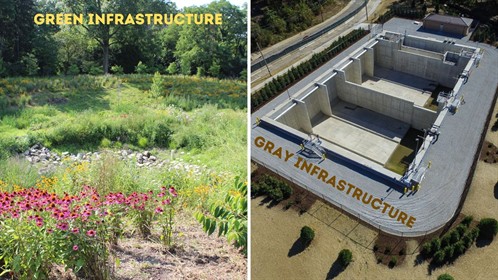 A common topic discussed in the world of water is green versus gray infrastructure because they both reduce stormwater runoff. Green and gray use different systems to rid and reroute stormwater runoff from urban environments. The process in how they reduce the stormwater runoff is what differentiates the systems.
A common topic discussed in the world of water is green versus gray infrastructure because they both reduce stormwater runoff. Green and gray use different systems to rid and reroute stormwater runoff from urban environments. The process in how they reduce the stormwater runoff is what differentiates the systems.
Green infrastructure incorporates engineered systems and the natural environment to harvest, reuse, infiltrate, and reduce the flow of stormwater into the sewer systems and the surface. It allows the stormwater to soak into the ground and filter out the pollutants naturally. Green infrastructure mimics the natural water cycle by retaining or detaining water by using natural areas that provide habitat. Green infrastructure uses rain gardens, infiltration planters, rainwater harvesting systems, permeable pavements, tree boxes, green roofs, and others for clean water and protection. This infrastructure restores and protects the natural water cycle.
Gray infrastructure is human-engineered infrastructure that has treatment facilities, sewer systems, stormwater systems, or storage basins. Gray infrastructure utilizes engineered systems to direct stormwater from certain locations to another. With these systems, the stormwater will travel through impermeable surfaces like drain pipes to be held in a storage basin during a large rain event or directly to a water reclamation facility for treatment. As water travels through, the systems will remove the pollutants and toxins carried by the stormwater to bring clean water back into the environment. This infrastructure places systems into the ground to remove toxins as water flows through it.
Overall green and gray infrastructure work to protect the environment by capturing and treating stormwater run-off before it is introduced back into the water cycle. The City of Akron uses both systems to treat water through the Akron Water Supply Plant, green infrastructure sites around the city, storage basins, and the Water Reclamation Facility, bringing clean water to residents in the community.
